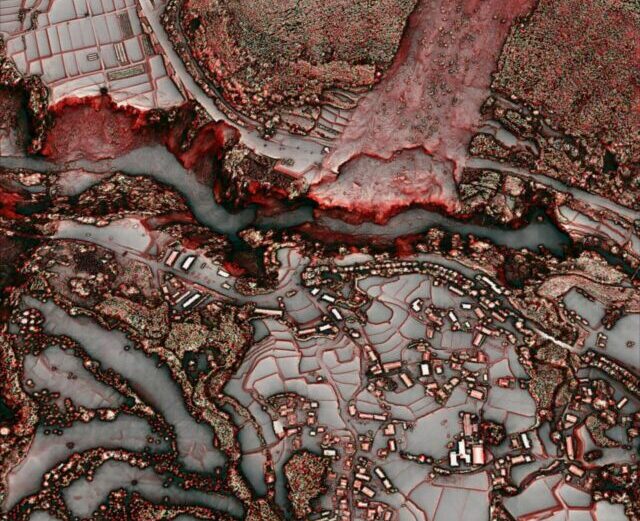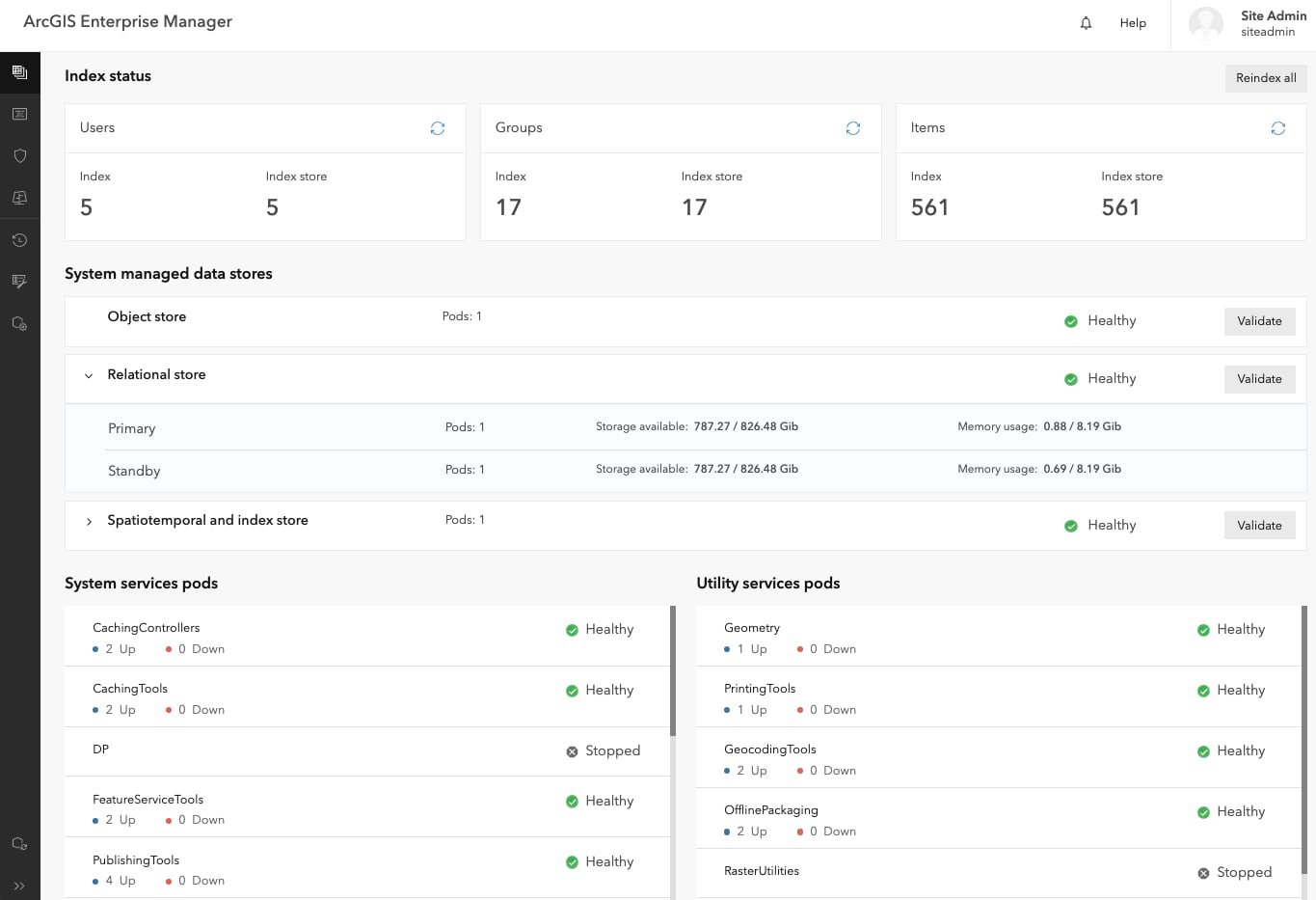ArcGIS Enterprise 11.1 on Kubernetes has released! This follows the recent release of ArcGIS Enterprise 11.1 on Windows and Linux. ArcGIS Enterprise on Kubernetes is available to all Esri customers through an annual subscription license. It runs in your environment and takes advantage of cloud-native software to deliver built-in high availability and scalability, while making things easier for administrators.
Beneath the surface, ArcGIS Enterprise on Kubernetes has a completely new architecture and can transform your geographic information system. However, users will retain the same familiar experience as they deliver maps and apps, perform analysis, and collaborate. Learn more in our documentation: Introduction and What’s new in this release. If you are wondering whether the software can address challenges you are facing, read Determine whether Kubernetes is right for you and talk with your Esri representative.
What’s new? A few highlights
ArcGIS Enterprise 11.1 on Kubernetes shares improvements and features with the software on Windows and Linux. You can find more details here. Below are a few examples of what’s new, specifically within the software on Kubernetes.
New! Containerized image services
We’re excited about the new ArcGIS Image Services on Kubernetes, released with 11.1, which you can license through an additional annual subscription. Now you can manage, process, and serve collections of imagery as image services directly within your existing deployment on Kubernetes. This gives you unparalleled control to tune, monitor, and scale your imagery processing workloads. Talk with your Esri representative if you are interested in ArcGIS Image Services on Kubernetes.

As before, you still have the option to federate a standalone ArcGIS Image Server with ArcGIS Enterprise on Kubernetes.
Enhancements to ArcGIS Enterprise Manager
ArcGIS Enterprise Manager is unique to the Kubernetes deployment option and has been improved in the 11.1 release. It gives you a central, simple view of the software and provides the user interface to scale services, configure security and backups, perform upgrades and updates, and more.

Improved Deployment and Upgrades
Customers tell us they are amazed at the administration experience with speedy upgrades and deployments, and we continue to make improvements. For example, we’ve added early failure detection to help the software recognize and respond quickly to underlying infrastructure disruptions. We’ve added more preventative measures to ensure success of an upgrade or to help the system recover quickly if something went wrong. The Helm Chart deployment package now integrates upgrades as well. We started including Helm support alongside our software starting at the 11.0 release.
Issues addressed
As always, each release also includes fixes. See the Release notes for further details. We have also continued to improve other areas of the software, such as the performance of map services at very large scale and internal error detection, logging, and recovery.
How can I upgrade to the 11.1 release on Kubernetes?
Before performing the upgrade, review the instructions at Upgrade and update requirements. If you are already running ArcGIS Enterprise 11.0 on Kubernetes, follow the steps in the upgrade process below. If you are deploying to an environment disconnected from the internet, first complete the prerequisite steps for a disconnected environment. If you experience issues or have questions, contact Esri Technical Support.
Upgrade process
- Review Upgrade and update requirements to ensure your environment is ready to upgrade.
- Take a backup, ensuring the retention period is disabled. After the upgrade is complete, the backup can be manually deleted.
- If you haven’t already, apply the ArcGIS Enterprise 11.0 on Kubernetes Q2 2023 Required Update from ArcGIS Enterprise Manager.
- From My Esri, download the license file for the 11.1 release on Kubernetes.
- From My Esri, download the package containing the pre-upgrade script and run the script to prepare your Kubernetes cluster.
- From ArcGIS Enterprise Manager, apply the 11.1 upgrade. As part of the upgrade process, you will be asked for the 11.1 license file.
Upgrade in a disconnected environment
- Review Upgrade or update in a disconnected environment.
- Refer to the Release Notes to identify the image tags for the 11.0 updates and 11.1 release. These images will be needed for the upgrade process.
- Run the create-offline-manifest.sh script to download and upload the latest manifest from Esri into your organization.
- Run the image-download.sh script to retrieve images from the Esri private repository, related to the tags identified in Step #2.
- Run the image-upload.sh script to import images to your own container registry, related to the tags identified in Step #2.
- Follow the Upgrade process steps mentioned above.
Capabilities available
Below is a summary of what is supported with ArcGIS Enterprise 11.1 on Kubernetes. It’s not a comprehensive list but represents commonly used functionality. Review the product documentation such as supported maps and GIS apps and the system requirements, for further details.
Supported Kubernetes environments
- Amazon AWS Elastic Kubernetes Service (EKS)
- Microsoft Azure Kubernetes Service (AKS)
- Google Cloud Kubernetes Engine (GKE)
- Red Hat OpenShift Container Platform
Not supported at 11.1 on Kubernetes:
- Red Hat OpenShift running as a managed service within the other cloud environments, e.g., ARO or ROSA
- Rancher, e.g., RKE-1 and RKE-2
- Other environments/services not listed as supported, e.g., AWS Fargate, EKS Anywhere, and Azure Container Apps
We continue to evaluate our customers’ needs and expand supported environments. For example, we will conduct an invitation-only beta test program for running our software on Rancher. Please see your Esri representative if you are interested in participating.
Deployment and upgrades
- Deploy an ArcGIS Enterprise organization in interactive or silent modes
- Configure an ArcGIS Enterprise organization using a setup wizard or script
- Upgrade or update the organization using ArcGIS Enterprise Manager or Administrator API
- Support for self-managed container image registries
- Select from several architecture profiles to optimize resources for high availability
- Support multiple deployments in the same cluster
- Support for fully disconnected environments
Administration
- Monitor and search logs
- Check health of system-managed stores
- Monitor system and utility service pod status
- Scale service and system deployments using ArcGIS Enterprise Manager or Administrator API
- Create and administer organization webhooks, and subscribe to service webhooks for geoprocessing and feature services
- Obtain and view service usage statistics
- Backup and restore the ArcGIS Enterprise organization using ArcGIS Enterprise Manager or Administrator API
- Recover access to the organization when administrative credentials are no longer available
Security
- Configure SAML and OpenID Connect
- Configure LDAP and Windows Active Directory
- Configure enterprise groups and users
- Configure web-tier authentication including IWA and PKI with ArcGIS Enterprise on Kubernetes Web Adaptor
- Enable 256-bit AES for passwords
Data management
- Support for Amazon Redshift, Google BigQuery, and Snowflake cloud data warehouses
- Register SQL Server, PostgreSQL, Oracle, and SAP HANA as databases
- Register your own data sources including folders and enterprise geodatabases
- Add network file shares as folder data stores mounted to the cluster
- Support for bulk publishing with an enterprise geodatabase
- Add items that access storage locations in Google Cloud
- Support for distributed collaboration including two-way editing
Creating and sharing content
- Publish map, feature, and geocode services
- Publish map, tile, and scene tile packages
- Publish hosted feature layers
- Conduct spatial analysis
- Publish from ArcGIS Pro 2.8 and higher
- Consume services from ArcGIS Pro 2.7 and higher
- Configure and share routing services
- Use web tools to share analysis across the organization
- Location sharing
- Publish image data sets as an imagery layer, running as a containerized service. Additional licensing is required.
- Support for ArcGIS Utility Network user type extension*
- Support for ArcGIS Parcel Fabric user type extension*
- Support for ArcGIS Trace Network user type extension
Server federation capabilities
- Federate a standalone ArcGIS GIS Server
- Federate a standalone ArcGIS Image Server (excludes raster analytics)
Not supported at 11.1 on Kubernetes:
- Federate an ArcGIS Notebook Server
- Federate an ArcGIS Workflow Manager Server
- Federate an ArcGIS GeoAnalytics Server
- Federate an ArcGIS GeoEvent Server
- Federate an ArcGIS Knowledge Server
Applications and extensions
- ArcGIS AppStudio
- ArcGIS Collector
- ArcGIS CityEngine
- ArcGIS Dashboards
- ArcGIS Drone2Map
- ArcGIS Earth
- ArcGIS Enterprise Sites
- ArcGIS Experience Builder
- ArcGIS Explorer
- ArcGIS Field Maps
- ArcGIS Instant Apps
- ArcGIS for Office and ArcGIS for SharePoint
- ArcGIS for Power BI
- ArcGIS Navigator
- ArcGIS QuickCapture
- ArcGIS Solutions
- ArcGIS StoryMaps
- ArcGIS Survey123
- ArcGIS Web AppBuilder
- ArcGIS Workforce
- Map Viewer
- Scene Viewer
- Parcel Fabric*
- Utility Network*
Not supported at 11.1 on Kubernetes:
- ArcGIS Business Analyst Enterprise
- ArcGIS Data Interoperability Extension
- ArcGIS Excalibur
- ArcGIS Insights
- ArcGIS Indoors and Space Planner
- ArcGIS Mission
- OrthoMaker
- Workflow Manager
*ArcGIS Parcel Fabric and ArcGIS Utility Network functionality is available, through an ArcGIS Server hosted on Windows or Linux. This server can be federated to an ArcGIS Enterprise on Kubernetes deployment.
Come talk to us!
As you can see, Esri continues to invest heavily in ArcGIS Enterprise on Kubernetes. Customers tell us they love the deployment and upgrade experience, the ability to tune and scale services, and the built-in high availability. The Esri Partner Network is also responding! Our partners are pursuing our brand-new Kubernetes Specialty to give you confidence in their management and consulting services on Kubernetes.
If you think Kubernetes might be right for you and you want to explore it further, please talk with your Esri representative. We would love to hear from you!





Commenting is not enabled for this article.